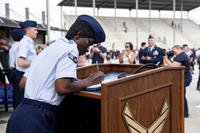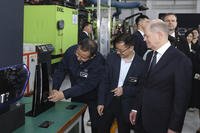Senior Army aviation officials on Tuesday watched flight demonstrations of a handful of prototype drones built for vertical takeoffs and landings, which the service hopes will lead to a rapid replacement of the 30-year-old RQ-7B Shadow.
On a rainy day at Fort Benning, Georgia, soldiers from five brigade combat teams, or BCTs, across the Army participated in the Future Tactical Unmanned Aerial System, or FTUAS, Rodeo. The event wrapped up months of field evaluations involving four UAS -- the Arcturus Jump 20, L3 Harris Unmanned Systems FVR-90, Martin UAV V-Bat, and Textron Systems Aerosonde Hybrid Quad.
"This is the culmination of an extremely successful soldier touch point for Future Tactical Unmanned Aerial Systems," Maj. Gen. David Francis, commander of the Army Aviation Center of Excellence at Fort Rucker, Alabama, told reporters during a roundtable discussion. "Today, we got a demonstration from each of the four vendors in less-than-ideal weather. It was cold, it was raining, and they all were able to launch, demonstrate the capabilities and recover each of their UAS systems successfully."
Read Next: Air Force Unveils Design of New PT Uniforms
Based on operational needs statements from the XVIII Airborne Corps, I Corps and the 25th infantry Division, the Army wants to field a Shadow replacement that's quieter, able to take off and land without a runway and transportable by CH-47 Chinook helicopter.
"We saw all of that and more. We saw a very agile system from every performer, and we saw the soldiers uniformly fall in love with this capability and want to keep it," said Brig. Gen. Walter Rugen, director of the Army's Future Vertical Lift Cross Functional Team.
But aviation officials at the demo were clear that the service is not ready to buy just yet. The results from the effort will be used to finalize a requirement document that is scheduled to go before the Army Requirements Oversight Council later this month for evaluation.
Brig. Gen. Robert Barrie, head of Program Executive Office Aviation, would not comment on a fielding timeline but said the Army has the funding resources to hold the FTUAS competition and put similar capability in the "hands of soldiers very rapidly."
Rugen added that BCTs clearly need a replacement for the Shadow as soon as possible.
"The demand signal from the field is significant, and so it's not something that this team, this enterprise, can ignore," he said. "The field is clamoring for this capability, and so I would say that I am not overstating it by saying that the Army is looking for opportunities to get this in the hands of soldiers rapidly."
Aviation officials said they were surprised that soldiers were able to control each of the prototypes while moving in a tactical vehicle.
"We didn't think we would be able to operate on the move, but all five BCTs, all four form factors operated on the move by which the aircraft was in flight and they were driving an FMTV or a Humvee," Rugen said. "That was tremendous."
Rugen was also impressed that all the prototypes were able to fly in the rain.
"Shadow could never fly in this type of moisture, couldn't even come close," he said.
Soldiers involved in the demos agreed that the Shadow is hindered by humid and rainy conditions but said that flying in the rain doesn't really add a tactical advantage.
Spc. Athenia Bailey of the 1st Armored Division 3rd Armored Brigade Combat Team said she noticed that cameras and other surveillance payload on all of the prototypes soon began to collect rain, which resulted in a loss of visibility.
"Your mission is to find stuff and target stuff and send it out to higher [commands], and you are not going to be able to do that for a long period of time when you are flying in the rain," Bailey told reporters.
Spc. Anthony Karl of the 1st Infantry Division's 1st Armored Brigade Combat Team said the vertical takeoff and landing capabilities of the new prototypes impressed him a lot more than their ability to fly in the rain because they are a lot easier to prepare for flight operations than the Shadow.
"You can take everything off of a truck to fly one of these systems -- and it's relatively the same across the board for all of them -- in a third or less of the time it takes to get one Shadow flight line set up," he said.
-- Matthew Cox can be reached at matthew.cox@military.com.
Related: Army Drone Rodeo Will Feature Textron's Vertical Takeoff UAS












